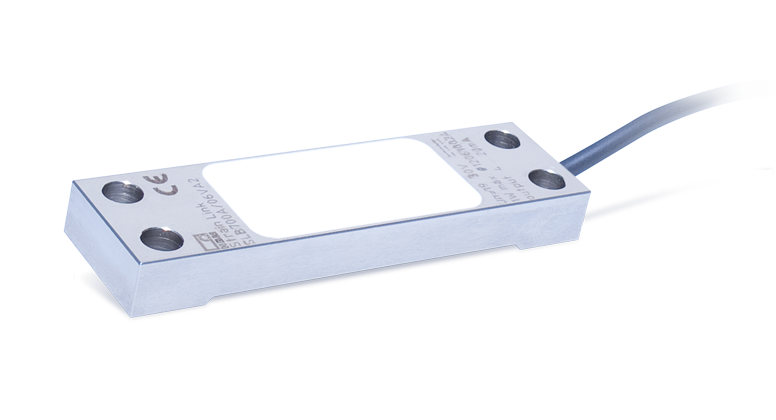Proven for years in production environments: Easy retrofitting of machines is possible due to the full compatibility of active and passive strain sensors.
SLB700A/06VA Active Strain Transducer: A Cost-effective Sensor with Integrated Electronics for Extremely High Forces
The SLB700A/06VA is a strain transducer with integrated electronics, which can easily be attached to structures with screws. If force is applied to the structure, the SLB700A/06VA reliably measures the resulting strain. Since the strain is often proportional to the force, the strain sensor can be used to measure the applied force, provided a corresponding calibration has been made. This principle is also called ‘measurement in the force shunt’.
The SLB700A/06VA active strain transducer is simply as robust as the passive version, that is, the SLB700A. However, the active SLB700A/06VA is more cost-effective, owing to its integrated measuring amplifier. The advantage of this attractively priced sensor is that it enables even extremely large forces to be measured in a reliable manner. The machine dynamics remain unaffected.
The teach-in procedure for the electronics utilized in the SLB700A/06VA is very simple. It only requires a measurement to be taken at the maximum force and another measurement at zero force. The output signal is scaled between these two points; irrespective of the strain level, the maximum possible signal will be transmitted to the next level in the measurement chain (refer to the explanation provided below).
The sensor materials withstand most of the oils used in applications involving presses and are rustproof.
Practical
- Easy mounting using four M6 screws
- Oil-resistant and a highly flexible cable, suitable for drag chains
- Compatible with the version without an amplifier; the two versions are interchangeable since they have identical dimensions and hole patterns

Cost-effective
- A cost-effective solution that provides an alternative to force sensors, particularly in cases of involvement of large process forces
- The machine dynamics remain unaffected
- Extremely cost-effective measurement chain, particularly due to the integrated bridge amplifier
- Calibration is easy, owing to the HBM teach-in procedure

Extremely cost-effective; enables extremely large forces to be measured, even on a tight budget. No additional electronics are required. An optimal resolution is guaranteed due to the teach-in procedure.
All-inclusive
- HBM also provides sensors for the calibration of the SLB700A/06VA
- Our service staff looks forward to calibrating your measurement chain for you

The cost-effective complete solution, ready to measure, available on request
Fast sensor teach-in. This is how it’s done:
Unlike our product, that is, the SLB700A/06VA, other available strain sensors with an integrated amplifier module only have a fixed amplification. For instance, 500 µm/m correspond to an output signal of 10 V. The fundamental drawback of this method is that the maximum output signal depends upon the given amplification, which cannot be changed. If, in the example above, a strain of 200 µm/m is utilized as the input signal, the resulting output voltage is 4 V. Particularly, when the next element in the measurement chain is a module that has a low resolution or increased noise (i.e., when economic aspects are of paramount importance), the results often are unsatisfactory.
SLB700A/06VA strain sensors from HBM, with integrated amplifier electronics, manage to bypass this problem, since they provide the maximum possible output signal at any time, independent of the intended purpose.
In order to achieve this, HBM has developed an extremely simple “teach-in procedure”.
- First, the sensor is installed in the usual manner, and the load on the machine (press, roll stand, silo) is reduced to zero. A longer pulse sent to the teach-in input is sufficient for the electronics to memorize the zero point.
- Subsequently, the maximum load is applied, sending another (this time, a SHORT one) pulse to the teach-in input is sufficient. Now, the electronics is adjusted between these two points.
- This enables the input range of the next level to be fully utilized at any time.
Further advantages:
- There is always a buffer of 10% in the upper and lower parts of the measuring range. Higher strain signals (e.g. in the event of a failure) are amplified and transmitted.
- The characteristic curve can also be negative. Both elongation and shortening can be converted into a positive signal.
- The built-in measuring amplifier provides low noise and a bandwidth of 2 kHz.
- It is essential to permanently store the span, i.e., the difference between the minimum and the maximum. Therefore, it is imperative to reset to zero after a power failure.
| Download the CAD step files for this product | ||
|---|---|---|
| SLB700A 06VA CAD step files |
Product Literature
| Title / Description | Language | Products | Language | Content Types |
|---|---|---|---|---|
| Data Sheets | ||||
| SLB700A/06VA1 / 06VA2 - Caractéristiques techniques | French | |||
| SLB700A/06VA1 / 06VA2 - Data Sheet | English | |||
| SLB700A/06VA1 / 06VA2 - Datenblatt | German | |||
| SLB700A/06VA1 / 06VA2 - データシート | Japanese | |||
| Mounting Instructions | ||||
| SLB700A/06VA1 / 06VA2 - Mounting instructions | French, German, English | |||
| Declaration of Conformity | ||||
| SLB700A - EU Declaration of Conformity | Multilanguage | |||
| SLB700A/06VA - EU Declaration of Conformity | Multilanguage | |||
